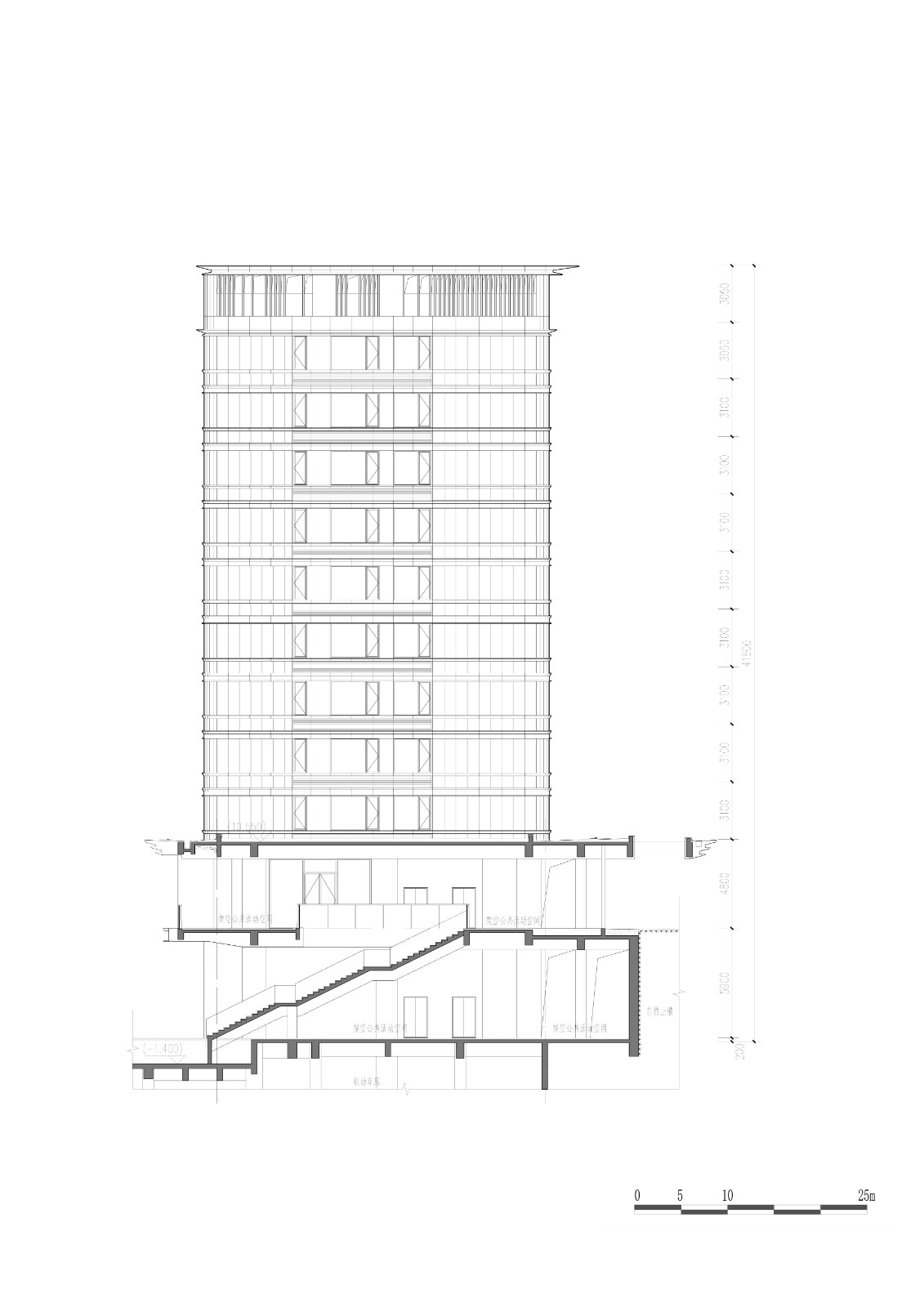 "/>
"/>
 "/>
"/>

设计单位|汉森伯盛国际设计集团
项目类型|建筑设计
项目地点|广州,天河区

“设备即建筑”的新型范式探索
01 项目概况/ Overview
项目位于广州的一处隐秘腹地,是2km景观绿轴的终点。设计者将建筑想象为都汇秘林,在车水马龙的城中打造隐于市的一方桃源。作为社区景观廊道的延续,项目顺应地势,打造了1.3万㎡的下沉式三层立体园林。这组由14座42m高的小高层建筑围合成的群落,是一组带有未来式宣言的建筑。在限定的408户样本中,建筑与设备自成体系,拥有自适应的冷热循环及先进的通风系统,被誉为“会呼吸的建筑”。
Located in the most secluded hinterland in Guangzhou, The Peakview is the endpoint of the 2km green axis. Imagined as a secret forest gathering point in the bustling city, the project was built as a hidden paradise. As a continuation of the green line of the community, the project utilises the terrain and creates a sunken garden of 13,000sqm. This low-density cluster, consisting of 14 structures with a height of 42m, is making a futuristic declaration. Among the limited sample of 408 households, architecture and equipment are self-contained as a complete system, with adaptive cold-and-hot cycles and an advanced ventilation system, which is known as the ‘breathing building’.

▲立面细部, Details ©是然建筑摄影

▲项目区位, Context Plan ©汉森伯盛

▲总平面图, Landscape Plan ©Cicada

▲鸟瞰园林, Sunken Garden ©是然建筑摄影

▲围合式园筑关系, Architecture-Garden Relation ©是然建筑摄影
02设备建筑一体化 /Equipment-building integration
得益于“恒适系统”的赋能,建筑可自主完成供暖、制冷和通风。“恒适系统”是一种比传统空调舒适度更高的空气调节系统,在高保温隔热的外围护基础上,采用毛细辐射对室内进行制冷或采暖。这是通过由陶瓷面板、铝板、断热铝合金双面Low-E镀银玻璃与外遮阳电动卷帘组成的体系实现的。设计能够有效地隔绝热气,减少建筑的冷却负荷,增强建筑的韧性。当需要供暖或制冷时,从每楼栋地下设备房汲取的水源通过内嵌入墙的毛细辐射管道循环流动,而达到控温的目的。
Empowered by the 'Constant System', the heating, cooling, and ventilation inside these buildings can be independently managed. The ‘Constant System’ is an air conditioning system with higher level of comfort than traditional ones, which adopts capillary radiation to cool or heat the indoor environment based on insulation and heat preservation. This is achieved through a system composed of ceramic panels, aluminium panels, insulated aluminium alloy double-sided Low-E silver plated glass, and the external sunshade electric roller blinds. Such design can effectively isolate the exterior heat and reducing the cooling load of the structure, which ultimately enhances the general resilience of the project. When heating or cooling is required, water that drawn from equipment rooms under each building respectively circulates through capillary radiation pipes embedded in the walls to achieve temperature control.

▲“恒适系统”立面, ‘Constant System’ ©是然建筑摄影

▲“恒适系统”外立面大样分析, Analysis Diagram of Façade ©汉森伯盛

▲下沉空间室内设计, Interior Design ©是然建筑摄影

▲下沉花园主入口, Main Entrance ©是然建筑摄影
03 高-低技结合/Integration of High-Low Techs
建筑立面采用陶板,是以建筑科学的角度再诠释传统的可再生材料。以黏土为基础材料,挤压成型,具有优异的耐久性,低技术生产的陶板完全覆盖建筑物的表面,为建筑提供了必要的遮阳,其独特的中空设计不但减轻了自身的重量,更促进了建筑表皮的空气流动。在夏日有助于隔热,在冬天能减缓释放热能的速度,有效降低建筑内外热传导,尽可能使建筑在全年保持恒温状态。与玻璃幕墙体系不同,陶材料表面满布孔隙,这种多孔结构可吸收部分声波,减少北侧和东侧快速路的噪音干扰。
Adopting a façade of ceramic panels, the project interprets traditional renewable materials from the perspective of Building Science. With clay as the basic material and extruded into shape, making it has excellent durability, the surface of building is fully covered with the low-tech produced ceramic panels. In addition to providing necessary shading for the building, such a unique hollow design reduces its weight, while improving air flow on the surface. Theoretically, the façade does help with insulation in summer and slows down the heat release in winter, ensuring the whole building at a stably and comfortable temperature range throughout the year. Unlike glass curtain wall systems, the material of ceramic is covered with pores, which can absorb sound waves and limit noise interference from expressways.

▲陶瓷材质立面, façade made of ceramic©是然建筑摄影

▲“恒适系统”分析, Analysis Diagram of‘Constant System’©汉森伯盛
建筑造型趋向于有机形态,刻意保留圆角与弧形,除了来自大自然的灵感,更重要的是弧形有利于气流循环,使建筑的热增益分布更均匀。为维持恒适系统运行效率最大化,建筑结构采用了五重保温隔热设计,对建筑不同墙体结构使用定制化的保温材料和策略。经能耗测算,全套技术体系的应用能使建筑达到70%-90%节能标准,比参照样本节约30%。
The style of architectural form tends to organic, deliberately retaining rounded corners and arcs. In addition to drawing inspiration from the nature, even more important though is the fact that arcs and rounded corners facilitate airflow circulation and delivering a more mild distribution of thermal gains. To maintain the maximum operational efficiency of the system, the structure adopts a five-fold heat-preservation design, and tailoring insulation materials and strategies for different components of the building. According to the energy consumption analysis, the application of a complete set of system enables buildings to achieve 70%-90% energy saving, reducing 30% compared to reference samples.

▲架空层灰空间, Grey Space ©是然建筑摄影

▲贯穿建筑的弧形设计, Arc-shaped Language of Design ©是然建筑摄影

▲立面圆角设计, Rounded Corners©是然建筑摄影

▲幕墙吊装过程, Ceramic Curtain Wall under Construction©汉森伯盛

▲建造中的幕墙细部, Details of Curtain Wall under Construction ©汉森伯盛

▲陶瓷幕墙构件, Components of Ceramic Curtain Wall ©汉森伯盛
04 理论重写/Rewrite
设计的成果来自于对当地人居住习性的研究,项目的关注点是如何在日益变化的生存环境下保持舒适体验的进阶,其目的是在停滞现状中发展出新的居住方式概念,实现更舒适并更高能效的未来居住表现。来自上海朗绿建筑科技的工程师参与了本案的跨学科合作,重点是开发符合本地域特征的气候适应性策略,以及就此对新型居住概念的引入。在这次的课题中,设备即建筑。传统的设计流程被颠覆,设备首次被置于项目设计的优先项。在自然环境日趋恶化的未来,用以调节建筑环境的设备体系将在空间营造中扮演前所未有的重要角色。一切,为了舒适。
The result of design starts as a study of the local habits on residential, with a focus on maintaining the evolution of experiencing comfort in the increasingly uncertain environment. The aim of this is to develop new living concepts under a stagnant situation, and further achieving more comfortable and better energy-efficient residential performance. Engineers from Landleaf Tech participated in this interdisciplinary collaboration topic, developing climate adaptive strategies that are in line with regional climate conditions, and assisting architects to introduce new concepts in response. Within this project, the equipment is as a building and vice versa. Traditional design process has been overturned, and the contribution of equipment has been prioritised for the first time. In the future, where the environment is deteriorating, the equipment system regulating the status of built environment will play an unprecedentedly role in space-making, for the sake of comfort.

▲外观立面夜景, Night View ©是然建筑摄影

▲内向立面夜景, Night View ©是然建筑摄影

▲北立面图, Elevation View ©汉森伯盛

▲剖面图, Section View ©汉森伯盛
项目信息
项目名称:E3实验住宅
方案设计:spdg
设计单位:汉森伯盛国际设计集团
主创团队:汉森伯盛高端住宅事业部
施工图设计:广州汉森建筑设计有限公司
室内设计:Martin Kemp Design、2pir Design
景观设计:Cicada
主要功能:居住建筑
建筑面积:157,437.54㎡
设计/竣工年份:2021/2024
项目地址:中国广东省广州市天河区汇景路
摄影版权:是然建筑摄影、汉森伯盛国际设计集团
Project Name: E3 Experimental Housing
Schematic Design: spdg
Architectural Design: Shing & Partners Design Group
Lead Designer Team: Shing & Partners High-end Residential Division
Working Drawings: Guangzhou Hansen Architectural Design Co., Ltd.
Category: Architectural design
Interior Design: Martin Kemp Design、2pir Design
Landscape Design: Cicada
Main Functions: Residential
Gross Building Area: 157,437.54㎡
Design/Completion Year: 2021/2024
Project Address: Huijing Road, Tianhe District, Guangzhou, Guangdong Province, China
Photography Copyright: Schran Images, Shing & Partners
专栏编辑|Sherry Li
审核编辑|Jingyi
若有涉及任何版权问题,请联系media@archidogs.com,我们将尽快妥善处理。

